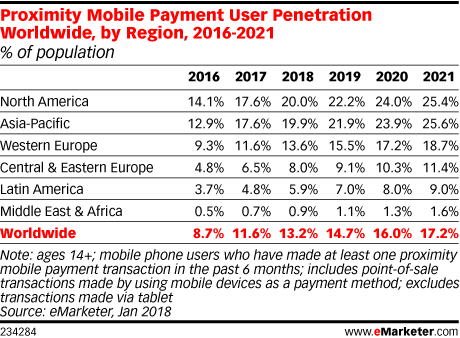Categories
Most Popular
Most Recent

Mobile Payments Aren’t Mainstream Yet
Editor-in-Chief - Small Business Expo | March 29, 2018
Mobile payments have yet to take off in the US—at least according to regularly published articles and reports. But how true is this?
According to a February 2018 survey of US internet users by CivicScience, only 1% of respondents use mobile payments as their primary payment method. Nearly half use debit cards (47%), while 26% use cash, and 23% rely on credit cards.
CivicScience probed into the reasons why US internet users are resistant to mobile payments and found that security fears were the leading hindrance by far, cited by 47% of respondents. By comparison, 15% said personal privacy was their main concern.

Millennials were the least deterred when it came to using a mobile payment app. Roughly a quarter (23%) of respondents ages 18 to 34 said there were no factors preventing them from using one, while 18% of Gen Xers and 9% of baby boomers felt the same. However, 40% of millennials still had security fears.
“The eMarketer Ecommerce Insights Report,” conducted in February 2018 by Bizrate Insights, specifically asked US internet users about their payment methods for digital purchases in the past month. Credit cards had the highest response rate, cited by 76.7%, but mobile payment apps made an appearance. Apple Pay secured the highest percentage, with 7.0% among total respondents. But that figure more than doubled to 14.4% among those ages 30 to 39, and to 11.1% for those 18 to 29. Google Wallet (1.4%), Android Pay (1.0%) and Samsung Pay (1.0%) had far lower usage among total respondents.
It’s not all about consumer adoption, though. In a chicken-and-egg situation, mobile payment users are limited to retailers that accept these forms of alternative payment—and most don’t at the moment.
A December 2017 survey of retailers in North America by BRP (Boston Retail Partners) found Apple Pay received the highest acceptance rate of alternative payment methods, cited by 37% of respondents, which lines up with the popularity of the service per Bizrate Insights. Additionally, over a quarter said they would accept Apple Pay within the next 12 months. Android Pay was accepted by 29% of retailers surveyed, while 66% said they would take a wait-and-see approach about Samsung Pay.
Analysis often compares the US with China, but China is unique in that the country has a disproportionately huge proximity mobile payment user penetration rate. In 2018, eMarketer estimates, 77.5% of smartphone users in China will use their mobile phone to pay for a purchase at the physical point-of-sale at least once every six months, compared with 25.3% in the US. For context, Denmark ranks second worldwide, with about half of China’s rate (38.9%).
However, North America is on par with Asia-Pacific when looking at proximity mobile payment users as a percentage of the population, at 20.0% in 2018, which is much higher than the worldwide average (13.2%).

US retailers do seem to have interest in adding mobile payment options, particularly Apple Pay, and eMarketer expects the number of proximity mobile payment users in the US will rise by 14.5% in 2018 to 55.0 million.
Content provided by eMarketer
.png?width=300&height=100&name=sbe-logo-greenblock-highres%20(1).png)